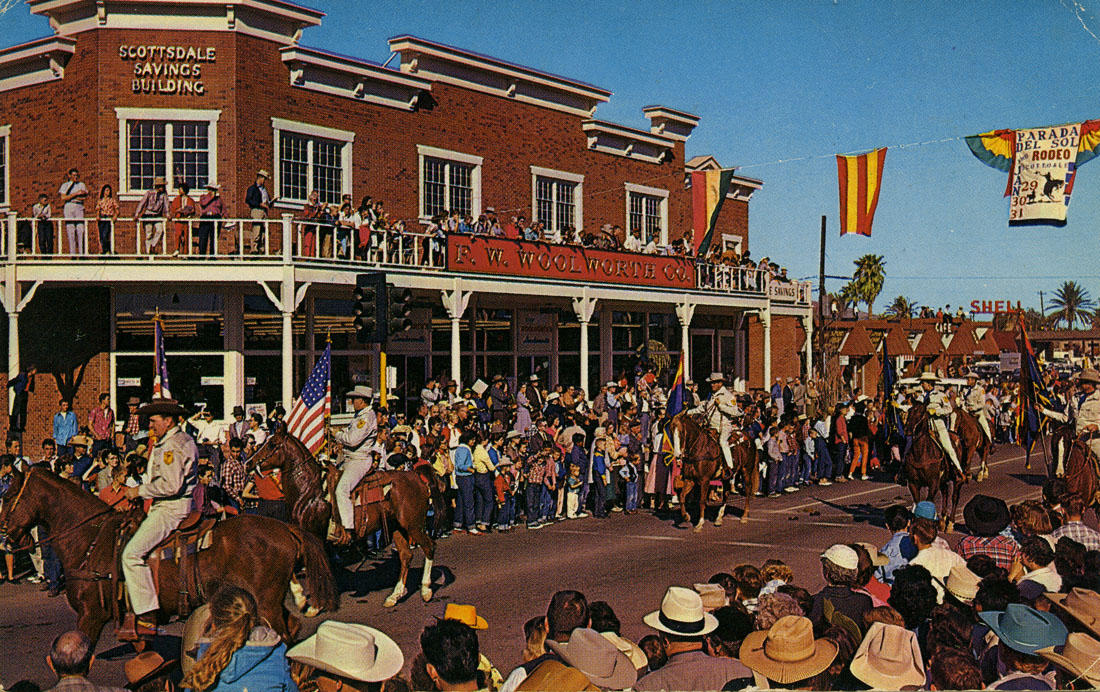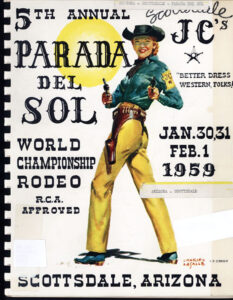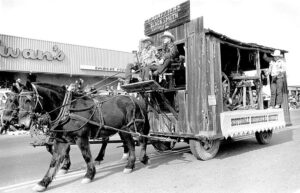Marching on Four Hooves

Writer Joseph J. Airdo
Photography Courtesy of the Evans Family Collection, the Scottsdale Historical Society and the Scottsdale Public Library
New York City has got Macy’s Thanksgiving Day Parade; Pasadena has got the Rose Bowl Parade; and Scottsdale has got Parada del Sol — a prestigious and treasured tradition that is as old as the city itself.
The annual parade attracts more than 30,000 people and provides the community an opportunity to showcase and celebrate its rich history that is steeped in Western roots.
“We are a farming and ranching community,” says Dennis Robbins, executive director of Scottsdale Charros — an all-volunteer, nonprofit group of business and civic leaders that supports youth sports, education and charitable causes and is now tasked with overseeing the parade each year. “Our history is that. So one of Parada del Sol’s goals is certainly to promote the Western heritage of Scottsdale.”
The story of Scottdale’s Western heritage stretches way back to 1888, when U.S. Army Chaplain Winfield Scott visited the Salt River Valley and, impressed with its potential, made a down payment on 640 acres of land to start a farming operation.
Parada del Sol’s seeds were planted 59 years later when, in 1947, a group of merchants led by Malcolm White — a man who, in 1951, became Scottsdale’s very first mayor — aspired to capitalize on the city’s potential as a tourism destination.
White and the then-new Scottsdale Chamber of Commerce began referring to Scottsdale as “The West’s Most Western Town” and integrating elements of that image, such as hitching posts and horse troughs, throughout the area.
The Scottsdale Chamber of Commerce partnered with a local riding club in 1951 to host the Sunshine Festival, which featured an entirely horse-drawn parade. It was a rousing success and cemented Scottsdale’s “West’s Most Western Town” moniker. In 1953, the event was renamed Parada del Sol and its management was assumed by the Scottsdale Jaycees.
Around the same time, a small group of Arabian horse owners founded the Arabian Horse Association of Arizona and hosted the first All Arabian Horse Show, further fossilizing the area’s uniquely equestrian lifestyle.
“The horse aspect is very unique to our parade,” says Robbins, noting that, although the Rose Bowl Parade also has an equestrian element, you do not see many horses in other parades.
A rodeo was added to the Parada del Sol festivities in 1956 and originally took place in the lot that is now home to Scottsdale Fashion Square.
“The parade would always be the same weekend as the rodeo,” says Robbins, who grew up in Scottsdale. “We used to have a half-day of school that Friday. The buses would pick us up at school and take us directly to the rodeo. Then we would go to the parade that Saturday.”
In 1959, more than two dozen horseback riders carrying U.S. mail — Holbrook’s Hashknife Pony Express — began traveling 200 miles from Holbrook to Scottsdale, where they would convene at the parade. The Howdy Dudettes — local high school girls who acted as ambassadors for the city, greeting visiting dignitaries and tourists — were also added to the roster, as were parade queens.



Dogs, ducks, geese, cattle and buffalo have all marched in the parade, which, at one point, even had a printed program.
Several high-profile celebrities have ridden in Parada del Sol over the years, including Amanda Blake — Miss Kitty from the 1950s television series “Gunsmoke” — in 1957 and country singer Buck Owens in 1987. The parade has also made celebrities of the many local students who have marched in it as part of their middle or high school band.
After all, promoting the western heritage of Scottsdale is only one of the parade’s goals.
“Another is to just bring the community together to enjoy the beautiful weather in February in Scottsdale,” Robbins says.
The weather this time of the year in Scottsdale does tend to be quite beautiful and, for many years, Parada del Sol organizers boasted that it had never rained on their parade. However, Arizona’s official state historian Marshall Trimble — who served as Parada del Sol’s grand marshall on four separate occasions — recalls the year during which it finally did.
“In 1986, John McCain and I were up at the front of the parade when off to the west I saw this huge cloud coming in — and it was moving fast,” Trimble says.
“There was an equestrian group right behind us. The band started playing, John and I turned the corner on Indian School Road and, as we headed down Scottsdale Road, we had not even gotten all the way around the corner when that storm hit. And that rain was a cloudburst. Being a Navy man and a Marine, John and I just soldiered on.”
As has the parade itself over the past seven decades, thanks primarily to a community that recognizes its historical value and cultural significance. When the Scottsdale Jaycees disbanded in 2008, people who loved Parada del Sol formed two separate committees — one that oversaw the parade and another that oversaw the rodeo. The two events became separate entities, despite still sharing the same name.
The rodeo — which moved closer to downtown Scottsdale in 1959 before pivoting to North Scottsdale’s Rawhide in 1985 — now takes place in March at WestWorld of Scottsdale.
The parade still takes place in February but has seen its route change slightly over the years as the city itself has changed. When Scottsdale Road was widened and medians were added, Parada del Sol participants could no longer interact with and engage onlookers who were suddenly far from the action.
Robbins says that, in recent years, organizers have taken care to create a much more intimate experience featuring a route around Old Town Scottsdale that resembles that of Parada del Sol’s humble beginnings.



This year’s 68th annual parade — which takes place on Saturday, Feb. 5 — embarks from Drinkwater Boulevard south down Scottsdale Road, turns right on First Street, then left on Marshall Way, turns east on Second Street and concludes heading north on Brown Avenue to Indian School Road.
The Trail’s End Festival — a big block party — begins immediately after the parade, featuring live concerts, food and fun for community members of all ages.
Robbins says that Scottsdale Charros is honored to have taken over the responsibility of making sure the parade marches on year after year.
“The city of Scottsdale really loves to have the parade and wants to continue to the tradition,” he says. “It is the longest continuous running event in our city. Scottsdale Charros has been riding in the parade as a group for more than 50 years. Part of our mission is to promote the Western heritage of Scottsdale and to promote Scottsdale in general, so it fits perfectly within what we are trying to accomplish as an organization.”
Robbins adds that it takes six or seven months to plan each year’s parade and that more than 100 volunteers work the day of the event to make sure Parada del Sol is pulled off without a hitch.
“It is lot of work for a lot of people,” he says. “But they love it and they are passionate about it. We canceled it last year [due to the COVID-19 pandemic], which was really unfortunate. So we are really excited to actually be having a parade again this year. We just want to make sure that we have the best and the safest parade possible. Just having it is a win for us this year.”
Experience
Parada del Sol // Saturday, Feb. 5 // 10 a.m. // Old Town Scottsdale // Free // scottsdaleparade.com

